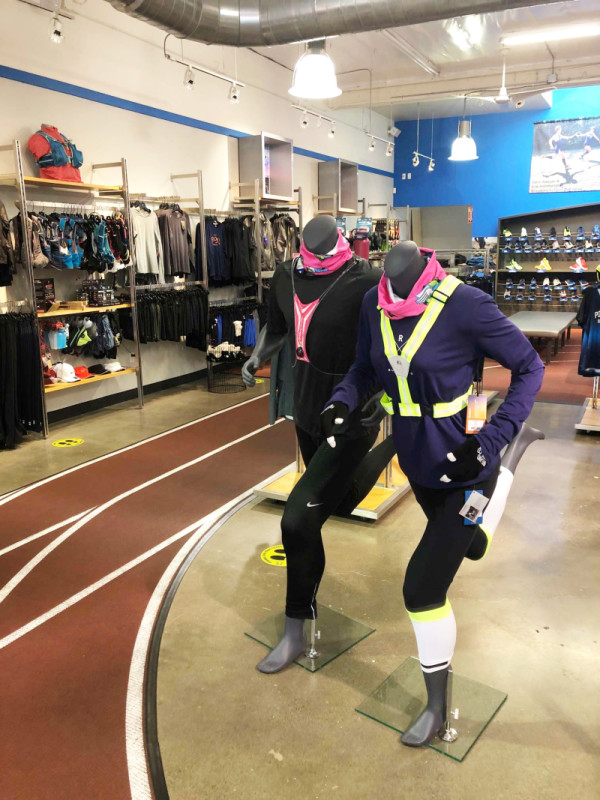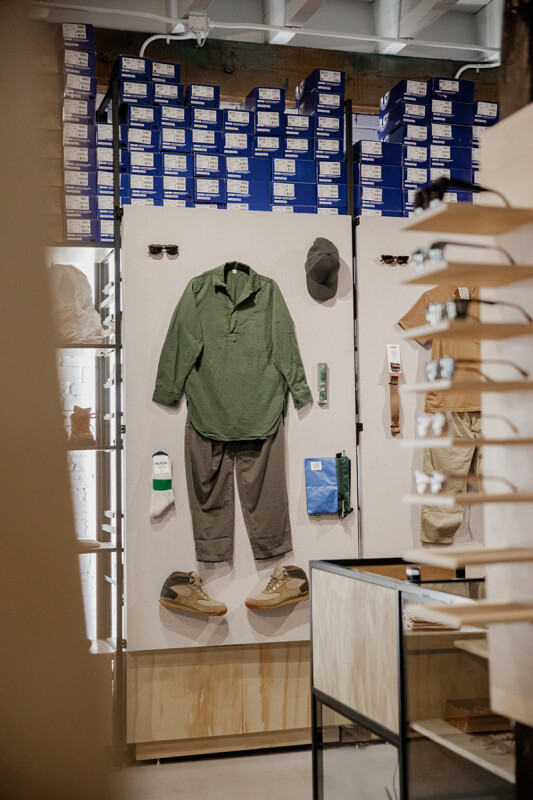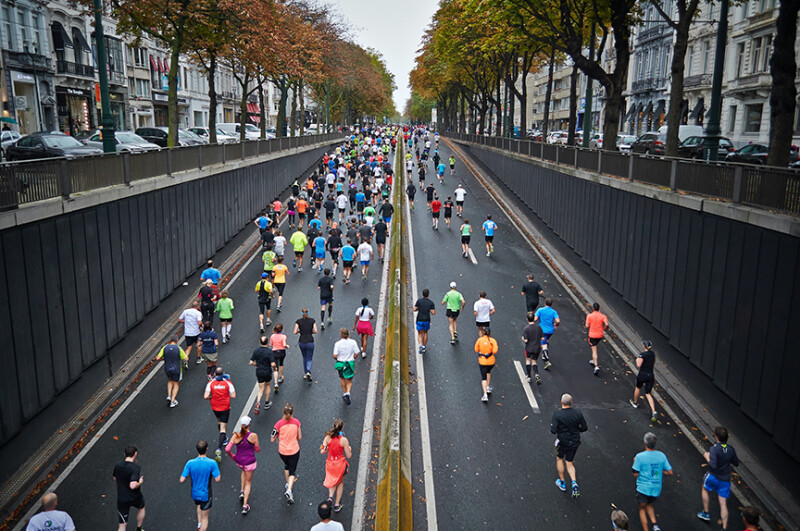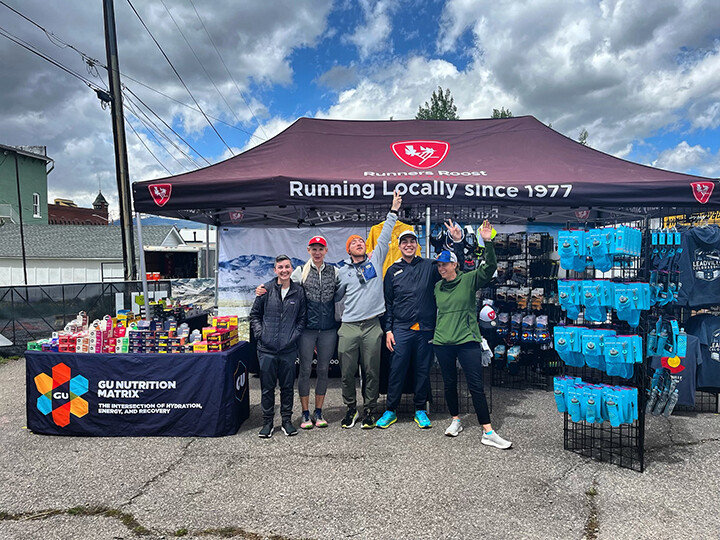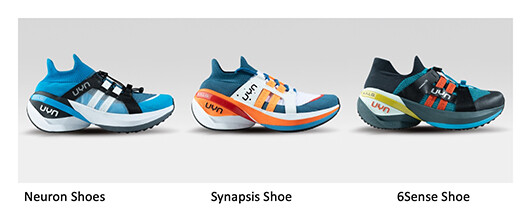For much of the last two decades at the helm of Portland Running Company in Oregon, Dave Harkin struggled with apparel, a plight familiar to many running retailers.
Shops like Portland Running Company, after all, built themselves on the shoulders of performance running footwear. Even as running apparel made impressive strides, vendors’ marketing engines hummed and run shops became more sophisticated with merchandising and purchasing, apparel largely lingered as an afterthought and many retailers strained to unlock success in the category.
“We know the things we love to run in, but apparel was always a difficult sell and we fell short,” admits Harkin, who co-owns the two-store operation with his wife, Paula.
Apparel and a Pandemic
But an interesting thing happened during the pandemic at Portland Running Company: Apparel began moving as customers consolidated their shopping efforts.
“We used to have to create the experience, but all of a sudden the experience was that they got to come into the shop,” Harkin says. “We had their attention in a different way and began looking for ways to boost the ticket beyond footwear.”
With extra intention and purpose, Portland Running Company staff actively touted apparel. They dove into customers’ workout routines and suggested suitable solutions. They spotlighted versatile apparel that transcended the run and heightened their focus on marketing apparel via social media. As a result, apparel revenue climbed at Portland Running Company, including a nearly 50 percent jump in men’s apparel sales.
“We had established ourselves as the authority on running and had that trust,” Harkin says. “We just needed to extend it.”
A similar tale played out at Charles River Running in Norwood, MA. There, owner Charlotte Walsh saw apparel sales, typically about 12 percent of her store’s annual revenue, score a noticeable leap as new runners and walkers hunkering to get outside gobbled up apparel.
“I sold through many items before they ever needed to be discounted,” Walsh says. “The product was selling itself.”
Though Luke Paulson did not see a substantial uptick in apparel sales at Jus’ Running in Asheville, NC, he acknowledges it has been “a little easier to sell apparel” since COVID-19’s arrival.
“We typically have to push apparel, mark it down and spend time with it on social media,” says Paulson, Jus’ Running’s manager. “Since March, I noticed customers coming in with a particular piece in mind. They were on a mission to find that windproof shell or tights.”
According to the Running Industry Association’s (RIA) Fourth Quarter 2020 Retailer Survey, nearly 40 percent of run shops saw 2020 apparel sales top their 2019 tally. That’s an undeniably positive sign given run specialty’s long-held struggles with apparel coupled with the challenges the pandemic thrust upon retail.
Run shops have embraced apparel more fully and are now angling to carry that momentum forward.
Leveraging Digital
For seven weeks beginning in March, The Running Well Store’s three locations in metro Kansas City were closed to the public.
“That’s when we would’ve moved all that spring apparel we brought in,” buyer Meredyth Melcher says. “Instead, we were the only ones seeing it on the wall.”
Like dozens of run shops across the country, The Running Well Store unveiled an e-commerce site in 2020 and leveraged that and affiliated digital tools to persuade purchases. (The number of specialty run retailers selling online jumped from 27 percent in March 2020 to nearly 90 percent at year’s end, according to RIA data.)
“Though people might go to the web store for something specific, we tried to entice them to scoop up apparel while they were at it,” Melcher says.
At Charles River Running, which debuted its online store in May, Walsh produced short Instagram TV videos providing straightforward information on apparel Ð “New people, in particular, don’t know what to wear under their pants,” Walsh reminds Ð while other run shops, including Jus’ Running, used social media to showcase the versatility of apparel in different environments.
“We’re definitely marketing comfortable lifestyle apparel as a solution given how much time people are spending at home,” Paulson says.
Throughout much of 2020, Walsh did not find customers dropping into Charles River Running for a leisurely shopping experience. Rather, she found purposeful shoppers armed with questions and prepared to buy.
“They’re here to get what they’re looking for and leave,” she says.
Service and Education
That shifting consumer behavior underscored the critical importance of friendly service and staff education, particularly the ability to call out product features and, more importantly, benefits. When associates can provide good-natured, expert assistance, the register can ring, especially with the new runners buying first-time products such as base layers and pants.
“They’re asking questions with genuine interest,” The Running Well Store’s Melcher says of customers, which includes a good number buying items for friends and family members who have become more active. “That’s given us an opportunity to educate customers on the value and quality of the products we have.”
Harkin has tried to facilitate conversation about apparel and other non-footwear items at the Portland Running Company by creating a more mobile checkout experience. Rather than a fixed register, staff conduct transactions on the sales floor with iPads. This, he says, allows staff to position customers near different product.
“And that’s created an opportunity for us to introduce apparel, recovery products, socks and other items in a way that feels more spontaneous,” Harkin says.
To facilitate social distancing, many run shops removed apparel racks from the floor, slimming down apparel presentations and removing duplicates to create a more streamlined look. Some even eliminated fitting rooms to gain floor space or, like Jus’ Running did for about two months at the onset of the pandemic, closed fitting rooms.
“Though we realized we were shooting ourselves in the foot with that,” Paulson says. “People still want to try on items.”
The Importance of Merchandising
Store windows and mannequins, meanwhile, became uber important to showcase apparel, with savvy retailers devoting more thought to what they were highlighting and how. This “real estate” took on added importance since customers were not casually shopping and stores needed to capitalize on any and every opportunity to grab in-store customers’ attention.
Recognizing shoppers’ more focused visits, Jus’ Running simplified apparel presentations inside its store. Paulson and crew abandoned organizing apparel by vendor collections and instead grouped like products together Ñ all the jackets in one spot, for instance, with all the tights in another.
“It’s more utilitarian and it’s worked for us,” Paulson says.
Calculated Ordering
Heading into 2020, Walsh thought she had her apparel purchasing figured out for Charles River Running. Then, COVID-19 hit. Some apparel simply did not show up, while Walsh cancelled some orders herself. By January 2021, she had little apparel on hand and few opportunities to fill in.
While pleased to have moved so much product at MSRP, Walsh also understands she lost some potential sales. Looking to avoid a similar fate this year, she bulked up her Fall 2021 ordering a bit, specifically leaning into tried-and-true brands that make quality apparel.
“My customer is looking for pants that will last seven years,” she says. “They want quality gear that doesn’t have an attitude.”
Future Buying
According to the RIA’s recent retail survey, nearly two-thirds of run shops plan to “sit tight” and take a normal percentage of their future orders, while 11 percent say they are under-inventoried and will look to bring in more product. One in four, meanwhile, will likely cancel or revise futures and pursue at-once availability.
Understandably, stores are wary of over-ordering, especially given the continued absence of races and expos as a vehicle to move apparel. Simultaneously, though, run shops acknowledge availability concerns with some vendors. They fear being caught empty handed and unable to deliver for customers.
“We can’t fill in willy nilly as we’ve done in the past,” Harkin says. “There has to be some real strategic thought to ordering these days.”
The Running Well Store’s plan to walk this tightrope? Melcher’s 2021 blueprint includes smaller runs, more apparel coming in more often and broader price ranges to accommodate diverse customer sets.
Diversifying the Product Mix
Technical running apparel continues to hold a prominent place in the run specialty environment as many consumers prioritize function. Warm and waterproof, for instance, still matter.
Increasingly, however, run shops are looking more holistically at apparel and directing added attention to ultra-comfy lifestyle pieces Ð yes, athleisure Ð as the lines between work, home and exercise blur. Joggers and running pants have been a hit at Jus’ Running, while the Portland Running Company has found success with insulated vests and thicker tops for men as well as yoga pants for women.
In the February issue of Running Insight, retail design pro Holly Wiese of 3 Dots Design called the athleisure trend “good news for running retailers” and urged them to focus more on comfort and less on technical. With more robust attention on lifestyle apparel, run shops can position themselves to be a destination for this sought-after apparel.
That’s certainly the hope of Portland Running Company’s Harkin, who has increased his apparel booking volume 10 percent and carefully diversified his product mix.
“I didn’t add new vendors, but I’ve relied on trusted partnerships and embraced lifestyle apparel,” he says.
